-
Engine4.3L V8
-
Power483 HP / 372 LB-FT
-
Transmission7-Speed DCT
-
0-60 Time3.7 Seconds
-
Top Speed193 MPH
-
DrivetrainRear-Wheel Drive
-
Curb Weight3,825 LBS
-
Seating2+2
-
Cargo8.5 / 12.0 CU-FT
A Rare Mid-life Updo Comes To The Starter Ferrari
Every time I travel to Maranello for a test drive, the three hours or so prior to turning the red key are driven in a U.S. Interstate-style straight line along Italy's A1 autostrada in my 99-horsepower 2001 Opel Astra station wagon with five-speed manual. It's just about the perfect antithetical setup for the unleashing of the hounds that awaits just over the hills south of Ferrari HQ.
This trip over was for the midlife upgrade of the Ferrari California for our 2013 model year, a car that promises to weigh less, deliver more horsepower and torque, and go quicker.
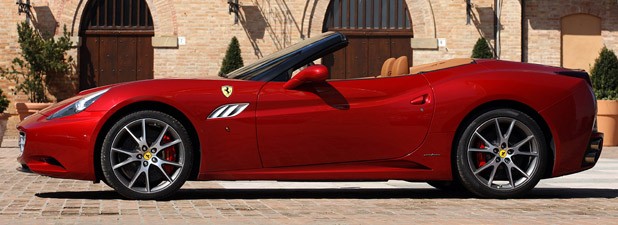
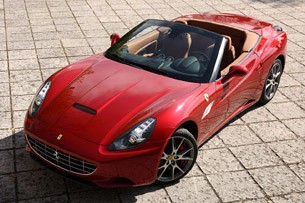
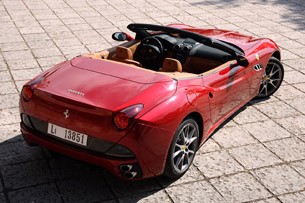
There is a generally agreed upon conversation about this upgrade that does not offend company authorities. The chat usually begins with admitting that the California is intentionally the softest Ferrari, has the least snappy steering and chassis dynamics, and is therefore most appealing to those new customers who want a Ferrari but who don't want a F-E-R-R-A-R-I. On that last point, the California has been a success; roughly 70 percent of the 8,000-plus units sold since the 2008 launch have gone to customers buying their first piece of Maranello. And the sales distribution has been fairly evenly parsed out, with 30 percent going to North America, 30 percent staying in Europe, 30 percent finding their way to Asia Pacific clients and the remaining 10 percent brightening driveways elsewhere.
But after having listened to this discourse way too many times, Ferrari has developed a dynamically improved California. The A-Number-One issue to be addressed was the amount of body roll in tight turns taken with gusto. (The Italians refer to it as "rollio" with the accent on the i.) More responsive steering feel with more weight in it and new spring and damper settings to lessen lean were two key items on the list.
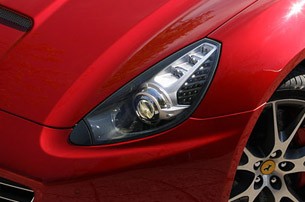
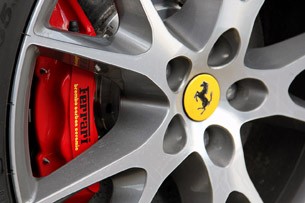
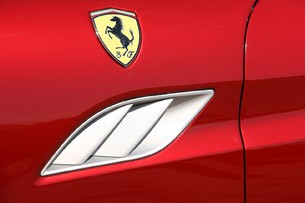
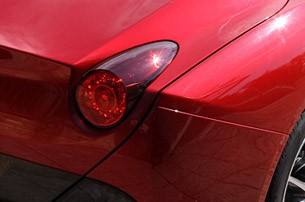
From my Apennine drive time, I can unequivocally state that the steering is definitely less frou-frou now, particularly when buyers add the new $7,300 "Handling Speciale" setup – the amount of input needed for tight turns is diminished by nine percent. With the California pre-HS, I used to have to do a little hand-over-hand for all the hairpins on the exciting drive route I typically seek out for these day trips. Now I nearly don't have to do any.
The $201,300 non-HS-enhanced California uses the same steering as before, but even it feels better now due to the greater punch from the powertrain and somewhat diminished roll in all those turns as a result of basic chassis modifications. So, yes, for the California HS you'd be paying around $208,600 base. In 2008, the first U.S.-bound California models had a base sticker of more like $194,000, but what's a few extra thou heaped on?
Perhaps most importantly, the twin stacked exhaust tips on any new California crackle and burn beautifully like never before when pushed. The four-into-one manifolds suffer less backpressure than before, too, and much of the increased power is realized here. My test car was playing right along with my four-to-three-to-two downshifts of the seven-speed automated dual-clutch manual gearbox through a whole slew of turns. (The very last Ferrari with a six-speed manual – reportedly a 599 GTB Fiorano for a U.K. customer – left the factory this past January. *sniff-sniff*). Within this exclusive segment of the sports car market, the California has an unrivaled voice.
Before we get right down to it, though – to those who toss out uninformed comments like, "Why spend like twice the money on a Maserati GranTurismo with a Ferrari badge on it?" please, get real. The chassis, drivetrain and body are completely different between the two cars. There is no GranTurismo with a folding hardtop, and the Maser's wheelbase is a massive 10.7 inches longer. The aluminum-full Ferrari is a much more exhilarating sports car when shoved around, whereas the steely GranTurismo is a sultry GT sex machine. The Maserati closest to the Ferrari California might be the GranTurismo MC at $139,900, yet it weighs 385 pounds more with 39 fewer horses from a larger capacity older engine shared most recently with the Alfa Romeo 8C Competizione and Spider. Sure, there were rumors that the original concept of a folding hardtop GT car was meant for the GranTurismo, but what does that matter?
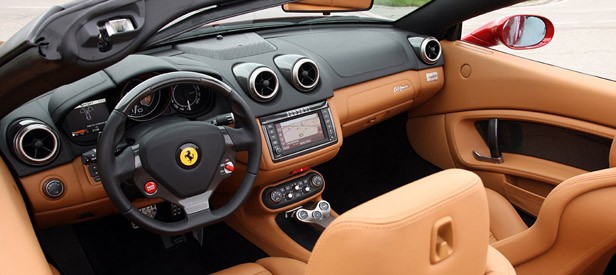
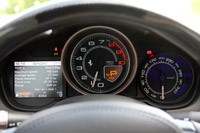
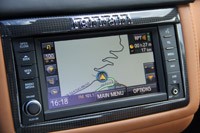
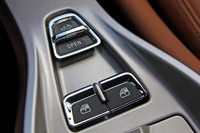
Sheesh. Okay, so, the changes to the stock (i.e. non HS) California are all under the skin, exactly where most great changes should be. I was shown the new spaceframe tweaks at the Scaglietti facility in Modena – nowadays Ferrari's center for aluminum expertise – and most of the standard mods are at the front end. The engine cradle is of the same design, but loses 13 pounds and gains rigidity by being made of aluminum now instead of steel. Local aluminum experts OMR build every Ferrari chassis in a facility near Brescia, and the California's construction requires twelve alloys plus an additional four new alloys for cast and extruded parts. Wall thicknesses up until now were between 1.0 and 1.5 millimeters, but on the latest car range between 0.9 and 1.1 mms. All in all, the California spaceframe is 60 percent new and is the source of each of those 66 lost pounds.
The main front longitudinal crash beams that used to work on four disjointed paths rearward are now set on three straighter and continuous paths that are much stronger, the topmost beams now lowered 1.2 inches to be level with the damper heads. A newly designed large upright main cast piece that joins all forward beams on both sides is also lighter and stiffer than before.
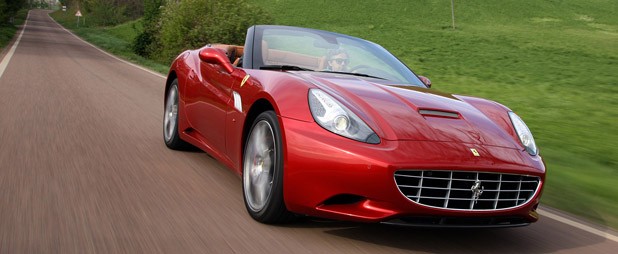
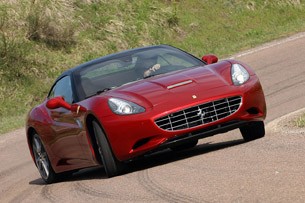
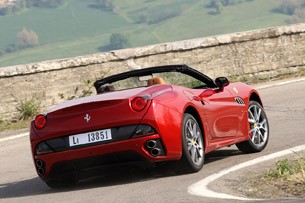
Then we get into the 4.3-liter direct-injected V8 engine revving away not far from one's toes. The 483 horses still max out at 7,750 rpm and the 372 pound-feet of torque (15 more than last year) still maxes at 5,000 rpm. Pumping losses that suck power and efficiency have been lessened by the inclusion of a new reed valve in the lower crankcase that ensures expelled oil and blow-by gases from each rev cycle never linger in or return to the crankcase. The piston crowns have been redesigned to better maximize the power from each direct-injected combustion, and the ECU has been reprogrammed to let the whole organism know it has these higher capabilities. It essentially means that you're getting to 60 mph from a standstill in just 3.7 seconds or less – two-tenths of a second quicker for Ferrari's "slow" starter car. Where I really felt the changes best was in my throttle play out in the boonies while squeezing all the revs from each gear and hearing it all yell through the valley from the redesigned exhaust.
Add the Handling Speciale shindig and everything just gets better still. Aside from the nine percent tighter steering ratio, the front springs are now 15 percent stiffer while the rears are 11 percent firmer. The standard SCM dampers (for "Sospensioni a Controllo Magnetoreologico") get a specific setup now that works with the new springs to lessen body roll and give the car a more rigid feel over the road. Working through the simplified manettino on the California's steering wheel, the differences between the Comfort, Sport and ESC Off settings are clear and purposeful – there is real comfort possible and then real sports car driving possible, and with ESC off, the driver can fling the tail around in any controlled wag they wish.
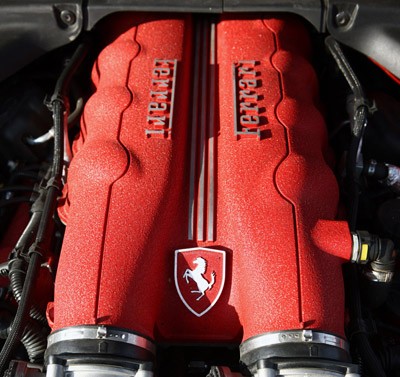
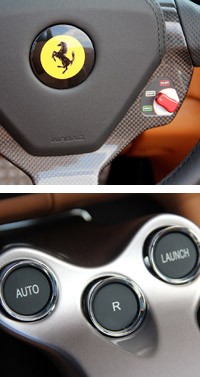
The HS trimmings are clearly worth going for if you want more of a F-E-R-R-A-R-I, but they manage to preserve the grand tourer qualities for every day driving with the roof wide open. The California still looks better to me with the roof shut than when it is open, as going top down accentuates the ungainly rear haunches that accommodate the roof in its cradle and the rear placement of the gearbox. But sitting in the car and going hard or soft is one of the best sports driving experiences yet in a GT car. The HS option also includes a few exterior touches as well, including an opaque silver-painted grille to go with the silver side blisters. All the same, Ferrari modestly says that they don't expect more than 15 to 20 percent of California orders to want the handling Speciale treatment. We'll beg to differ and say more like 50 percent of people will order it... if they're smart.
Most pleasing on the fully tricked California HS is a newfound ability to let the tail out while maintaining tremendous control. The Pirelli P Zero treads – 245/35 ZR20 95Y front and 285/35 ZR20 100Y rear – and standard carbon ceramic brakeset seems to come to life more fully with this upgraded chassis, especially when bearing HS hardware.
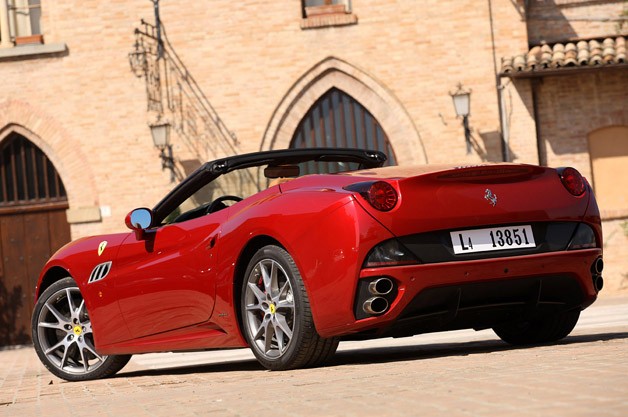
As the California is the model that has significantly upped the average annual mileage of the Ferrari range of cars, Maranello announced toward the end of last year that it was including a seven-year free standard maintenance program with every purchase of any model. This is part of the deal now for all markets worldwide and Ferrari is the first ultra-premium manufacturer to toss this in. And if a buyer sells their car on, the new owner still gets the benefit of the time remaining on the maintenance contract. The Ferrari of ten years ago – heck, of five years ago – would have laughed at the idea of something like this ever happening at the company.
Consider it proof that it sometimes takes a softer Ferrari to force the hard decisions.
Every time I travel to Maranello for a test drive, the three hours or so prior to turning the red key are driven in a U.S. Interstate-style straight line along Italy's A1 autostrada in my 99-horsepower 2001 Opel Astra station wagon with five-speed manual. It's just about the perfect antithetical setup for the unleashing of the hounds that awaits just over the hills south of Ferrari HQ.
This trip over was for the midlife upgrade of the Ferrari California for our 2013 model year, a car that promises to weigh less, deliver more horsepower and torque, and go quicker.



There is a generally agreed upon conversation about this upgrade that does not offend company authorities. The chat usually begins with admitting that the California is intentionally the softest Ferrari, has the least snappy steering and chassis dynamics, and is therefore most appealing to those new customers who want a Ferrari but who don't want a F-E-R-R-A-R-I. On that last point, the California has been a success; roughly 70 percent of the 8,000-plus units sold since the 2008 launch have gone to customers buying their first piece of Maranello. And the sales distribution has been fairly evenly parsed out, with 30 percent going to North America, 30 percent staying in Europe, 30 percent finding their way to Asia Pacific clients and the remaining 10 percent brightening driveways elsewhere.
But after having listened to this discourse way too many times, Ferrari has developed a dynamically improved California. The A-Number-One issue to be addressed was the amount of body roll in tight turns taken with gusto. (The Italians refer to it as "rollio" with the accent on the i.) More responsive steering feel with more weight in it and new spring and damper settings to lessen lean were two key items on the list.




From my Apennine drive time, I can unequivocally state that the steering is definitely less frou-frou now, particularly when buyers add the new $7,300 "Handling Speciale" setup – the amount of input needed for tight turns is diminished by nine percent. With the California pre-HS, I used to have to do a little hand-over-hand for all the hairpins on the exciting drive route I typically seek out for these day trips. Now I nearly don't have to do any.
The $201,300 non-HS-enhanced California uses the same steering as before, but even it feels better now due to the greater punch from the powertrain and somewhat diminished roll in all those turns as a result of basic chassis modifications. So, yes, for the California HS you'd be paying around $208,600 base. In 2008, the first U.S.-bound California models had a base sticker of more like $194,000, but what's a few extra thou heaped on?
Perhaps most importantly, the twin stacked exhaust tips on any new California crackle and burn beautifully like never before when pushed. The four-into-one manifolds suffer less backpressure than before, too, and much of the increased power is realized here. My test car was playing right along with my four-to-three-to-two downshifts of the seven-speed automated dual-clutch manual gearbox through a whole slew of turns. (The very last Ferrari with a six-speed manual – reportedly a 599 GTB Fiorano for a U.K. customer – left the factory this past January. *sniff-sniff*). Within this exclusive segment of the sports car market, the California has an unrivaled voice.
Before we get right down to it, though – to those who toss out uninformed comments like, "Why spend like twice the money on a Maserati GranTurismo with a Ferrari badge on it?" please, get real. The chassis, drivetrain and body are completely different between the two cars. There is no GranTurismo with a folding hardtop, and the Maser's wheelbase is a massive 10.7 inches longer. The aluminum-full Ferrari is a much more exhilarating sports car when shoved around, whereas the steely GranTurismo is a sultry GT sex machine. The Maserati closest to the Ferrari California might be the GranTurismo MC at $139,900, yet it weighs 385 pounds more with 39 fewer horses from a larger capacity older engine shared most recently with the Alfa Romeo 8C Competizione and Spider. Sure, there were rumors that the original concept of a folding hardtop GT car was meant for the GranTurismo, but what does that matter?




Sheesh. Okay, so, the changes to the stock (i.e. non HS) California are all under the skin, exactly where most great changes should be. I was shown the new spaceframe tweaks at the Scaglietti facility in Modena – nowadays Ferrari's center for aluminum expertise – and most of the standard mods are at the front end. The engine cradle is of the same design, but loses 13 pounds and gains rigidity by being made of aluminum now instead of steel. Local aluminum experts OMR build every Ferrari chassis in a facility near Brescia, and the California's construction requires twelve alloys plus an additional four new alloys for cast and extruded parts. Wall thicknesses up until now were between 1.0 and 1.5 millimeters, but on the latest car range between 0.9 and 1.1 mms. All in all, the California spaceframe is 60 percent new and is the source of each of those 66 lost pounds.
The main front longitudinal crash beams that used to work on four disjointed paths rearward are now set on three straighter and continuous paths that are much stronger, the topmost beams now lowered 1.2 inches to be level with the damper heads. A newly designed large upright main cast piece that joins all forward beams on both sides is also lighter and stiffer than before.



Then we get into the 4.3-liter direct-injected V8 engine revving away not far from one's toes. The 483 horses still max out at 7,750 rpm and the 372 pound-feet of torque (15 more than last year) still maxes at 5,000 rpm. Pumping losses that suck power and efficiency have been lessened by the inclusion of a new reed valve in the lower crankcase that ensures expelled oil and blow-by gases from each rev cycle never linger in or return to the crankcase. The piston crowns have been redesigned to better maximize the power from each direct-injected combustion, and the ECU has been reprogrammed to let the whole organism know it has these higher capabilities. It essentially means that you're getting to 60 mph from a standstill in just 3.7 seconds or less – two-tenths of a second quicker for Ferrari's "slow" starter car. Where I really felt the changes best was in my throttle play out in the boonies while squeezing all the revs from each gear and hearing it all yell through the valley from the redesigned exhaust.
Add the Handling Speciale shindig and everything just gets better still. Aside from the nine percent tighter steering ratio, the front springs are now 15 percent stiffer while the rears are 11 percent firmer. The standard SCM dampers (for "Sospensioni a Controllo Magnetoreologico") get a specific setup now that works with the new springs to lessen body roll and give the car a more rigid feel over the road. Working through the simplified manettino on the California's steering wheel, the differences between the Comfort, Sport and ESC Off settings are clear and purposeful – there is real comfort possible and then real sports car driving possible, and with ESC off, the driver can fling the tail around in any controlled wag they wish.


The HS trimmings are clearly worth going for if you want more of a F-E-R-R-A-R-I, but they manage to preserve the grand tourer qualities for every day driving with the roof wide open. The California still looks better to me with the roof shut than when it is open, as going top down accentuates the ungainly rear haunches that accommodate the roof in its cradle and the rear placement of the gearbox. But sitting in the car and going hard or soft is one of the best sports driving experiences yet in a GT car. The HS option also includes a few exterior touches as well, including an opaque silver-painted grille to go with the silver side blisters. All the same, Ferrari modestly says that they don't expect more than 15 to 20 percent of California orders to want the handling Speciale treatment. We'll beg to differ and say more like 50 percent of people will order it... if they're smart.
Most pleasing on the fully tricked California HS is a newfound ability to let the tail out while maintaining tremendous control. The Pirelli P Zero treads – 245/35 ZR20 95Y front and 285/35 ZR20 100Y rear – and standard carbon ceramic brakeset seems to come to life more fully with this upgraded chassis, especially when bearing HS hardware.

As the California is the model that has significantly upped the average annual mileage of the Ferrari range of cars, Maranello announced toward the end of last year that it was including a seven-year free standard maintenance program with every purchase of any model. This is part of the deal now for all markets worldwide and Ferrari is the first ultra-premium manufacturer to toss this in. And if a buyer sells their car on, the new owner still gets the benefit of the time remaining on the maintenance contract. The Ferrari of ten years ago – heck, of five years ago – would have laughed at the idea of something like this ever happening at the company.
Consider it proof that it sometimes takes a softer Ferrari to force the hard decisions.
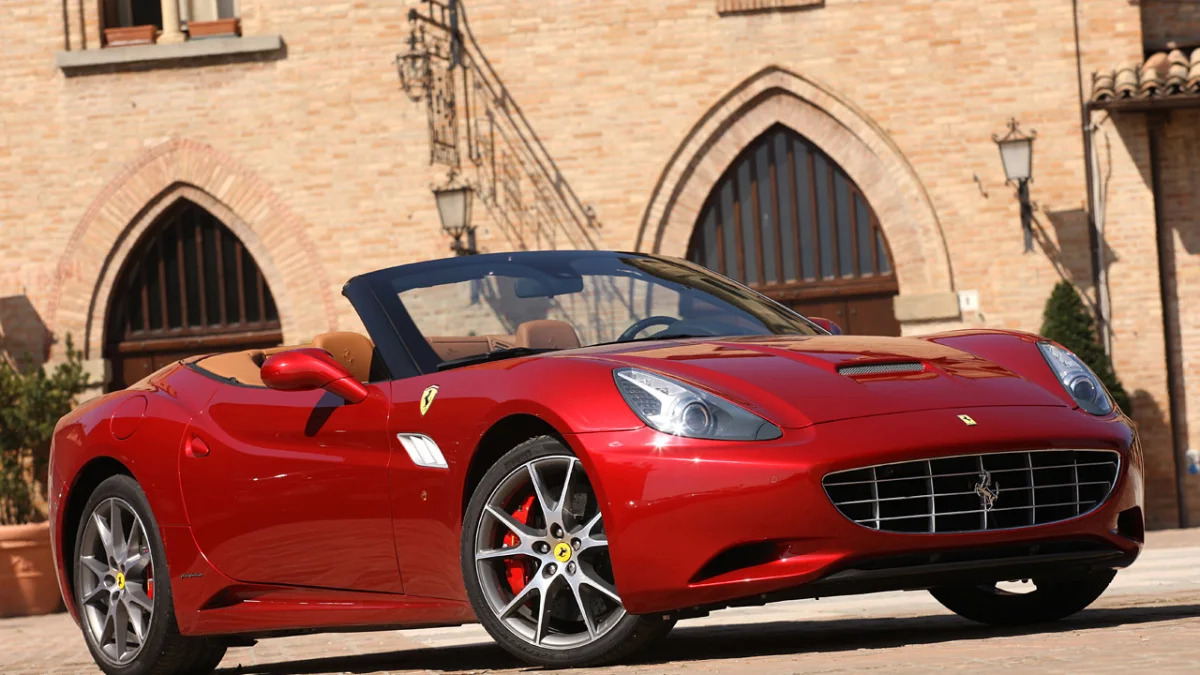









Sign in to post
Please sign in to leave a comment.
Continue